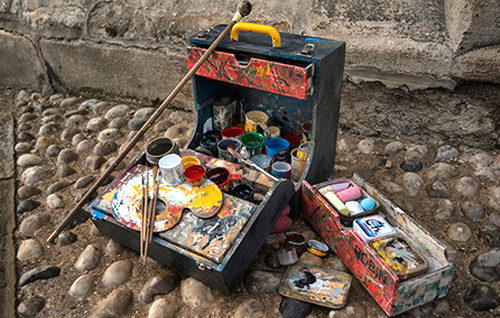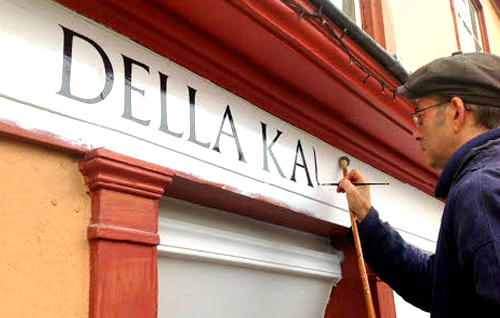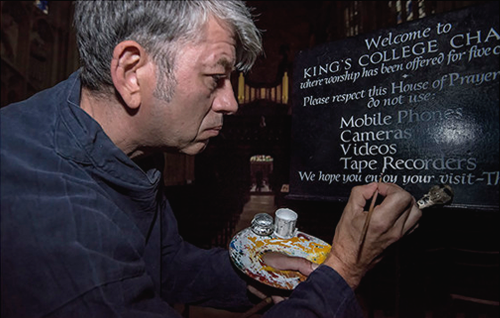-
Are signwriters becoming extinct in Cambridge?

Robin Taylor is one of the last full-time signwriters left working in and around Cambridge. He hand-paints those oars that rowing crews get for their successes and does all sorts of signage for the colleges. His diary is exceedingly busy, especially around now when the colleges want their undergrads’ names on the walls. For that he gets help from otherwise-retired lettering experts. There are very few signwriters working full-time in Cambridge nowadays and when I meet up with Robin in a café off Newmarket’s High Street, near where he lives, he accepts there’s a danger that the unthinkable could happen if he doesn’t take on an apprentice at some point: Cambridge could have no proper signwriter to do the oars for its winning crews. "When the vinyl cutting revolution happened in the 1980s lots of people threw themselves into that," he explains.
Signwriting survives partly because it’s one of those trades where "it’s not really a job, it’s a vocation" and partly because it involves art and artistry as well as high-level mechanical skills – and a computer can only deliver half that equation. Robin left school at 16 for an apprenticeship at Swainland Signs "in Broad Street off the East Road – it was the oldest established sign firm in Cambridge". That lasted three years. "We were trained to memorise what is now called a font – Roman, Helvetica, Gil Sans, Old English – we would be able to either draw or paint them very quickly, marking them out on a board. That would be hard to teach someone."
Even if no-one commissioned a single new sign in Cambridge there would be work for a signwriter ad infinitum. "Churches, Masonic lodges, the Cambridge Lawn Tennis Club, the colleges – they all have honours boards, and they need updating, and they’re finding it harder to find a signwriter. There were 30 or 40 of us when I started, now there’s me and one other gentleman close to retirement which is why I want to take on an apprentice in the next five years. I’ve had approaches but there’s no magic way to learn: it takes time, you have to be interested."
When practiced in public, the skill on display draws crowds. "I went in straight from school – Linton Village College – and the work has changed a lot. The customers are more discerning, they like the signs and even want to watch it being painted, they want it to be done by a human being. I’m a tourist attraction when I work – I never saw that coming, I tell you. I did a shop in Market Square last week, you never know what the next job’s going to be, I’ve done classic vehicles, boats, airplanes, Chevy trucks, Rolls-Royces . . . It’s not too bad if you have Rolls-Royce and King’s College on your client list, is it?"
The oars Robin paints – "the oar is the biggest sporting trophy of all, they’re 12 and a half feet long" – are built to last. "Ultimately they’ll last for years, if you go to the boathouses they’ve got oars of more than 100 years old." The legacy a signwriter brings to his customers isn’t just in the work he does – it’s in ensuring that the craft will live on for another 100 years. Without signwriting the quality of cultural life in the city would take a tumble, the harmony of our heritage would start to fall into desuetude. "In the lettering world if someone is genuinely interested, people will help, it’s not competitive, it’s about sharing knowledge, it’s all about the bigger picture. People want to hand the baton on. Young people are intrigued and when they see the work they go ‘wow’: it’s done by a human, they can look at it and it has lasting value."
It’s quite a responsibility because Cambridge "used to have some of the best world-class letter carvers" – but Robin’s journey has had its share of twists and turns too. Towards the end of the 1980s he "got involved with exhibition graphics, I went to trade shows all over Europe and America". It was the time when the profession was being redefined by the arrival of the cut vinyl era and Robin, having dabbled, decided it wasn’t for him. "By the mid-90s I was getting bored with exhibition work and it occurred to me that I enjoyed signage. I decided I wanted to get back into hand lettering so I looked around and I found a course at West Dean in Chichester which had been set up by Edward James, a friend of Salvador Dali. The letter carving course was run by Tom Perkins, who was himself trained by Richard Kindersley.
"Then I was farmed out to Tommy Banford, who was generally seen as the king of the oars. His oars are the best you’ll ever see. He had a workshop in Bene’t Street, we got along all right, he was a nice chap – he was in his 80s then. He’d been trained by Eric Gill. He used to take me round the colleges and he’d show me things . . ." So many characters – and not just letters! – but Mr James stands out. "He was related to kings. At one point he tried to build a futuristic city in the South American jungle, he was a friend of Magritte. He brought lots of pieces of work with him, like the lobster telephone, and his legacy was set up at West Dean College, it’s still there, it’s a wicked place with footprints in carpets and fibre-glass tree stumps, a really nice atmosphere."
He then showed up at Eric Marland’s studio which was based at an old chapel off Huntingdon Road, the one where Wittgenstein is buried in the graveyard. "Of course, when you have these experiences, you learn from them and it’s very much ‘I never thought of that’." Another bend in the road occurred when one of the signwriters had an eye accident and could no longer focus on the finer detail of the lettering. "I offered to help and that’s when I restarted doing it – this was the late 90s. So it’s been something I’ve been doing the last 15 or 20 years." Robin likes Newmarket, which is where he moved to in 1998. "I lived in Brighton from 1988-98 but essentially think of myself as a local person, I was born and grew up here. It’s a very friendly place.
"Newmarket has its own unique thing with the Flat racing of course – it’s the best Flat racing in the world. Near my home is King James’ Palace, they’re doing it up, they’ve realised it’s a unique place. "Horses have the right of way in parts of the town, not that many places have that, they’re beautiful animals. I wake up to the sound of horses hooves clip-clopping down the street. I’ve seen the Queen here just a couple of weeks ago." Robin is one of those gentlemen who ensure that Cambridge and environs stay in touch with its traditions, traditions which have been weathered and enriched through generations, and it’s an absolute must to ensure such craftsmanship doesn’t have a full stop with this generation.
For further information:
Robin James Taylor – Traditional Hand Painted Signs
07843 496563
robinjtaylor.signwriter@gmail.com
http://robinjtaylor-signwriter.co.uk/.
Sorry, there were no replies found.
Log in to reply.





